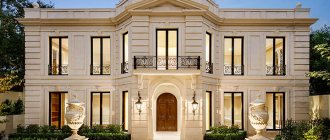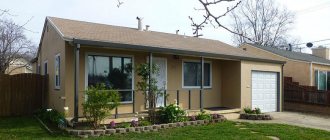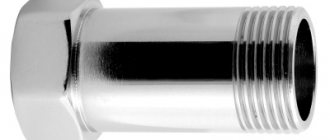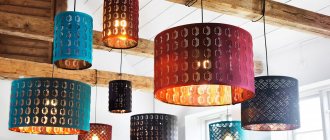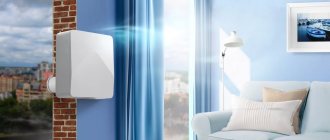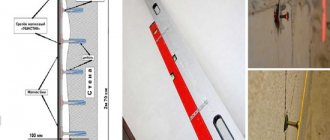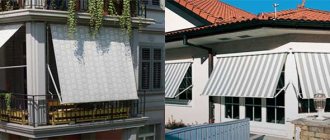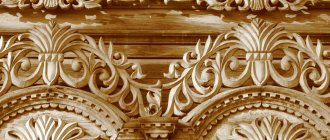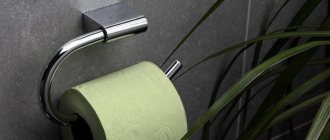The facades of a furniture set determine its attractiveness from the outside, helping to create an atmosphere of comfort and coziness in the room. At the same time, they are subject to great working requirements - the front panels of furniture must withstand high temperatures, be moisture-resistant and durable.
Paneled (framed) facades, which advantageously combine practicality and modern design, are in demand.
Paneled facades - what are they? Specifics and advantages of the design
Framed facades are structures consisting of two components: a base and a frame.
Such designs are sometimes called paneled - from the word “panel” (German “fullung” - “filling”), which means a quadrangular-shaped decorative component placed in a frame.
The positive qualities of frame panels include:
- reducing the weight of furniture due to the use of thin and light panels;
- excellent operating qualities - resistance to high temperatures and air humidity;
- the opportunity to save money by purchasing a facade with an expensive external coating and a very cheap base;
- high elegance and a huge selection of colors.
The facades of physical panels are not constructed heavily: thin panels are placed in the frame, which is already ready, and are fixed in specialized grooves using shaped overlays. To secure the structure, specialized glazing beads are used, which are placed on glue or nails.
Features of door repair
The main reasons for restoration of wooden doors:
— subsidence of structures caused by failure of hinges or the use of unsuitable fasteners;
- weakly reinforced boxes;
— wear of various fragments of the door leaf;
— unsticking and warping of panels;
- poor opening and closing, the appearance of extraneous sounds.
— the need to eliminate deficiencies in external finishing.
Types of furniture paneled facades
Framing for panels can be made from a variety of materials:
- Chipboard;
- MDF;
- real wood;
- aluminum
Chipboard frames are very popular due to their reduced price. Otherwise, they are not so flawless - they cannot boast of durability, they absorb moisture and odors.
MDF structures are considered one of the best combinations of reasonable price and excellent quality. Medium-density fiberboard framing is environmentally friendly, safe and resistant to adverse external factors.
A frame furniture façade made of real wood will cost much more, but is very popular due to the ability to give the furniture a noble look. Basically, MDF, trimmed with veneer - a thin layer of wood - is used as a panel in such products. From the outside and to the touch, such panels are indistinguishable from solid solid wood facades.
Aluminum frames are distinguished by their very high resistance to wear, hygiene and durability. Also, they are great for the interiors of our time.
Watch the video on how to repair wooden doors
When choosing fasteners, it is very important to pay special attention to their thread - for repairing doors, only screws with sharp threads are suitable, which cuts well and does not crush wood fibers.
Also quite popular parts used in restoration work on wooden doors are hinges. Their design consists of a hinge and two cards with holes for screws.
As a rule, hinges come in three types: with a rod embedded inside the hinge; with a rod embedded in one card and with a removable rod. When repairing a wooden door, you must ensure that both cards are in the same plane with the door bar, otherwise it will not close tightly.
Types of internal filling of a frame facade
Depending on the shape, panel inserts can be:
- flat - they are completely smooth panels without any protrusions or overlays;
- volumetric - with the presence of figured protrusions or carved adjustments;
- typesetting - consist of individual lamellas that are connected to each other;
- figarean - with a convex central part, gradually turning into much thinner edges;
- floating - with inserts of the same thickness as the frame.
Floating panels are considered an excellent option for rooms where humidity almost always changes, for example, a kitchen or bathroom - they do not cause distortions and cracks in the facade when the size of the inserts changes under the influence of unsaturated air.
Depending on the material, the panels can be:
- from MDF covered with laminate or chipboard;
- real wood;
- veneered MDF;
- glass;
- plywood.
The insert usually has not only a square and quadrangular shape. In individual artistic projects for furniture sets, there are also round, oval, trapezoidal and even polygonal panels.
The frame front of the cabinet looks great on its own, but it is often further decorated with:
- carved and forged components - decorative overlays made of metal and wood;
- triplex - laminated glass with a wide variety of effects;
- stained glass - patterns on translucent surfaces.
The panels made from pieces of various materials look original.
Materials
The first necessity when repairing wooden doors are screws of different sizes with countersunk, semi-countersunk and semi-round heads. Their length can vary between 7–120 mm, thickness 1.6–10 mm.
Countersunk head screws, used for fixing door hinges, installing mortise locks and other elements, are screwed into the wood of the structure exclusively flush.
To install handles, all kinds of latches, and rim locks, the following type of fasteners can be used, the heads of which will not be an obstacle to the tight closing of the door and the functioning of all its mechanisms.
Design of the style of paneled facades
Physical panel facades have been used since the Middle Ages and have not lost their former popularity.
Designers nowadays are guided by the experience of centuries-old foundations and offer panels suitable for a variety of style solutions:
- Gothic (peak popularity from the 11th - 12th to 15th - 16th centuries) - furniture in this extravagant design is characterized by pointed arches, multi-colored stained glass windows, wood carvings and unusual forged parts;
- Baroque is a luxurious style brought to Russia by Peter I. It is characterized by rich decoration of facades with stucco and carvings. The use of panels of original shapes is encouraged - with curls and spirals;
- classicism (XVIII-IXX centuries) - a balanced and correct style. The framed facades are made in two contrasting colors and are discreetly decorated with forged elements and marquetry.
Cabinet fronts made in modernist styles, for example, minimalism or hi-tech, are distinguished by clear lines and little decoration.
Elimination of wear on door bars
When locks are frequently replaced, it often happens that fragments of door bars at the insertion points become severely deformed. In order to get rid of this shortcoming, you will need a wooden V-shaped “patch”. When making such a part, it is important to take into account that only well-dried, high-quality wood is suitable for work.
A hole of the appropriate shape is cut out in the damaged block, after which an insert is placed there, carefully coated with wood glue and additionally secured with screws or dowels.
Also for these purposes, a rectangular part with straight spikes can be used.
In case of pronounced deformations of the lower part of the door, remove the destroyed block and then replace it with a similar part. It is advisable to install it not dry, but using glue and securing the bar with dowels. In some cases (for example, if the front door is being repaired), a plinth in the form of a wide board can be made in its lower part. This measure will protect the structure from rapid destruction resulting from frequent opening of doors by kicking.
Restoration of panels
If the door leaf dries out and forms unsightly cracks, the repair technology will depend on the complexity of the individual case. So, cracks about 2 mm wide are carefully cleaned, covered with putty and dried. Wider cracks are sealed with inserts made of wood that matches the texture.
Reconstruction of the panels is carried out with the door removed from its hinges, on a flat horizontal surface. The canvas is cleaned of the old coating, sanded with fine sandpaper, cracks are eliminated using the methods described above, after which the prepared surface is primed, painted and coated with a layer of varnish.
There is often a situation where paneled doors become unstuck, lose their shape and become warped. In this case, the door is removed from its hinges, carefully disassembled, and the corner joints are cleaned of dust accumulated during operation.
When doing this type of work, it is important to remember that this method is only suitable for those cases where the paneled part is secured with layouts; if it is inserted into the grooves of the frame bars, then it is not advisable to disassemble the door.
After cleaning, all joints are carefully coated with high-quality wood glue, the strapping bars are connected in reverse order and the panels are returned to their places. Dowels are used to secure all structural elements.
A simpler way to repair paneled doors involves strengthening the corner joints with metal corners installed on one or both sides and secured with screws. If necessary, the corners are primed and painted to match the color of the door leaf.
